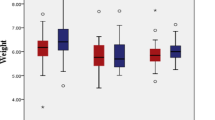Abstract
Separability is an attractive feature of covariance matrices or matrix variate data, which can improve and simplify many multivariate procedures. Due to its importance, testing separability has attracted much attention in the past. The procedures in the literature are of two types, likelihood ratio test (LRT) and Rao’s score test (RST). Both are based on the normality assumption or the large-sample asymptotic properties of the test statistics. In this paper, we develop a new approach that is very different from existing ones. We propose to reformulate the null hypothesis (the separability of a covariance matrix of interest) into many sub-hypotheses (the separability of the sub-matrices of the covariance matrix), which are testable using a permutation based procedure. We then combine the testing results of sub-hypotheses using the Bonferroni and two-stage additive procedures. Our permutation based procedures are inherently distribution free; thus it is robust to non-normality of the data. In addition, unlike the LRT, they are applicable to situations when the sample size is smaller than the number of unknown parameters in the covariance matrix. Our numerical study and data examples show the advantages of our procedures over the existing LRT and RST.



Similar content being viewed by others
References
Anderson TW (2003) An introduction to multivariate statistical analysis, 3rd edn. Wiley, New York
Allen GI, Tibshirani R (2012) Inference with transposable data: modelling the effects of row and column correlations. J R Stat Soc Ser B Stat Methodol 74(4):721–743
Bertoluzzo F, Pesarin F, Salmaso L (2013) On multi-sided permutation tests. Commun Stat Simul Comput 42(6):1380–1390
Dawid AP (1981) Some matrix-variate distribution theory: notational considerations and a Bayesian application. Biometrika 68(1):265–274
Dutilleul P (1999) The mle algorithm for the matrix normal distribution. J Stat Comput Simul 64(2):105–123
Filipiak K, Klein D, Roy A (2016) Score test for a separable covariance structure with the first component as compound symmetric correlation matrix. J Multivar Anal 150:105–124
Filipiak K, Klein D, Roy A (2017) A comparison of likelihood ratio tests and Rao’s score test for three separable covariance matrix structures. Biom J 59:192–215
Finos L, Salmaso L (2005) A new nonparametric approach for multiplicity control: optimal subset procedures. Comput Stat 20(4):643–654
Fuentes M (2006) Testing for separability of spatial-temporal covariance functions. J Stat Plan Inference 136(2):447–466
Glanz H, Carvalho L (2013) An expectation-maximization algorithm for the matrix normal distribution. arXiv preprint arXiv:1309.6609
Gupta AK, Nagar DK (1999) Matrix variate distribution. Chapman Hall/CRC, New York
Henze N, Zirkler B (1990) A class of invariant consistent tests for multivariate normality. Commun Stat Theory Methods 19(10):3595–3617
Hothorn T, Hornik K, van de Wiel MA, Zeileis A (2017) Package “coin”. Conditional inference procedures in a permutation test framework. ver. 1.2-2. 2017. https://cran.r-project.org/web/packages/coin/index.html. Accessed 02 July 2018
Klingenberg B, Solari A, Salmaso L, Pesarin F (2009) Testing marginal homogeneity against stochastic order in multivariate ordinal data. Biometrics 65(2):452–462
Korkmaz S, Goksuluk D, Zararsiz D (2014) MVN: an R package for assessing multivariate normality. R J 6(2):151–162
Lee SJ, Lee S, Lim J, Ahn SJ, Kim TW (2007) Cluster analysis of tooth size in subjects with normal occlusion. Am J Orthod Dentofac Orthop 132(6):796–800
Lee SH, Bachman AH, Yu D, Lim J, Ardekani BA (2016) Predicting progression from mild cognitive impairment to Alzheimers disease using longitudinal callosal atrophy. Alzheimers Dement Diagn Assess Dis Monit 2:68–74
Li B, Genton MG, Sherman M (2007) A nonparametric assessment of properties of space–time covariance functions. J Am Stat Assoc 102(478):736–744
Li E, Lim J, Lee S-J (2010) Likelihood ratio test for correlated multivariate samples. J Multivar Anal 101(3):541–554
Li E, Lim J, Kim K, Lee S-J (2012) Distribution-free tests of mean vectors and covariance matrices for multivariate paired data. Metrika 75(6):833–854
Lu N, Zimmerman DL (2005) The likelihood ratio test for a separable covariance matrix. Stat Probab Lett 73(4):449–457
Mardia KV (1970) Measures of multivariate skewness and kurtosis with applications. Biometrika 57(3):519–530
Mitchell MW, Genton MG, Gumpertz ML (2006) A likelihood ratio test for separability of covariances. J Multivar Anal 97(5):1025–1043
Pesarin F, Salmaso L (2010) Permutation tests for complex data. Wiley, New York
Roy A, Leiva R (2008) Likelihood ratio tests for triply multivariate data with structured correlation on spatial repeated measurements. Stat Probab Lett 78(13):1971–1980
Roy A, Leiva R (2011) Estimating and testing a structured covariance matrix for three-level multivariate data. Commun Stat Theory Methods 40(11):1945–1963
Royston P (1983) Some techniques for assessing multivariate normality based on the Shapiro–Wilk W. Appl Stat 32(2):121–133
Royston P (1992) Approximating the Shapiro–Wilk W test for non-normality. Stat Comput 2(3):117–119
Shapiro SS, Wilk MB (1964) An analysis of variance test for normality (complete samples). Biometrika 52:591–611
Sheng J, Qiu P (2007) p-Value calculation for multi-stage additive tests. J Stat Comput Simul 77(12):1057–1064
Strasser H, Weber C (1999) On the asymptotic theory of permutation statistics. Math Methods Stat 8(2):220–250
Tan KM, Witten D (2014) Sparse biclustering of transposable data. J Comput Gr Stat 23(4):985–1008
Viroli C (2010) Finite mixtures of matrix normal distributions for classifying three-way data. Stat Comput 21(4):511–522
Wang X, Stokes L, Lim J, Chen M (2006) Concomitant of multivariate order statistics with application to judgment post-stratification. J Am Stat Assoc 101:1693–1704
Wang H, West M (2009) Bayesian analysis of matrix normal graphical models. Biometrika 96(4):821–834
Yin J, Li H (2012) Model selection and estimation in the matrix normal graphical model. J Multivar Anal 107:119–140
Acknowledgements
We are grateful to the Associate Editor and two anonymous reviewers for their many helpful comments. The R-package “NPCovSepTest” of the proposed procedure is online available from https://sites.google.com/view/seongohpark/software. J. Lim’s research is supported by National Research Foundation of Korea (Nos. NRF-2017R1A2B2012264; MIST-2011-0030810).
Author information
Authors and Affiliations
Corresponding author
Rights and permissions
About this article
Cite this article
Park, S., Lim, J., Wang, X. et al. Permutation based testing on covariance separability. Comput Stat 34, 865–883 (2019). https://doi.org/10.1007/s00180-018-0839-2
Received:
Accepted:
Published:
Issue Date:
DOI: https://doi.org/10.1007/s00180-018-0839-2




